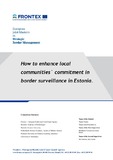How to enhance local communities' commitment in border surveillance in Estonia
Kokkuvõte
Assistant Police Officers in Estonia have been actively involved in public security already since 1994, with Governmental order in 2010 Police Board, Border Guard Board and Migration and Citizenship Boards were merged into one organisation and since then there is possibility to use Assistant Police Officers for guarding the European Union external borders as well. Unknown reasons Assistant Police Officers are mostly involved in public security and only few of them have been contributing with voluntary work into border surveillance. The aim of this research is to analyse with Allen, Meyer and Smith Organisational Commitment and Occupational Commitment Questionnaires Assistant Police Officers commitment to organisation and occupation, with Hackman and Oldham “Job Diagnostic Survey” work satisfaction and author’s questions readiness to invest personal money and time to current work. The purpose of focus group interview was to deal with the same questions and get confirmation or denial.
Kirjeldus
1. Introduction ; 1.1. Volunteers around the world ; 1.2. Volunteers in Police activities ; 1.3. Volunteers in Estonian Police activities ; 2. Literature review ; 2.1. Work Commitment ; 2.2. Commitment to the organisation ; 2.3. Dimensions to commitment ; 2.3.1. Affective commitment ; 2.3.2. Continuance Commitment ; 2.3.3. Normative Commitment ; 2.4. Commitment to occupation ; 2.5. The characteristics of the workplace. ; 3. Research Methodology ; 3.1. Research design ; 3.2. Data collection and usage of data ; 3.3. Data analysis ; 3.4. Sample strategy ; 3.5. Research quality indicators ; 3.6. Ethical issues ; 3.7. Limitations in research ; 3.8. Hypothesis ; 4. Analysis and Results ; 4.1. Descriptive statistical analysis ; 4.2. Explanatory statistical analysis ; 4.3. T-test and differences between groups ; 4.4. Correlations and Relationships between sub scales ; 4.5. Interview analysis outcome ; 5. Conclusion and Recommendations ; 5.1. Summary ; 5.2. Further research possibilities ; 5.3. Recommendations



